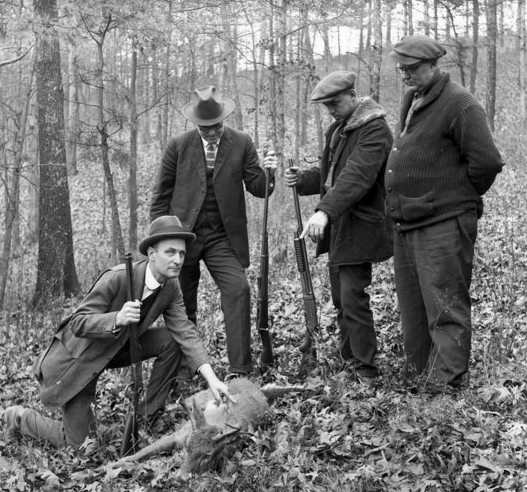For hunting enthusiasts of the time, Oct. 11, 1936, must have been an exciting day. “The entire Pisgah National Game preserve of 85,000 acres will be opened for deer hunting by permit during November and December,” the Sunday edition of the Asheville Citizen-Times reported. “This is the first time in the history of the preserve that the entire area has been opened for hunting.”
Bambi fans, fear not! Hunters were prohibited from shooting does and fawns. Only bucks with visible antlers were fair game, the Sunday edition explained, in an effort to “reduce a ‘surplus crop’ of deer.” (Granted, by session’s end, 40 does were reported dead and three men arrested.)
The same day’s paper also announced Pisgah’s six-day open season on squirrels. For $1 a day, eager hunters could kill up to 10 fidgety rodents. Like the planned deer hunt, the squirrel expedition came with a number of rules and regulations, including restrictions on the type of guns and ammunition used. Dogs were prohibited from the outing, as well, and a permit was also required.
“You may think this sounds a little complicated just for a few days of squirrel hunting,” the paper read, “but there are plenty of squirrels in the forest and you should be amply repaid with game and a good time.”
According to reports, 72 hunters partook in the Oct. 12-18 outings, resulting in 244 dead rodents.
By month’s end, the Chamber of Commerce hosted a drawing to select winners for Pisgah’s deer hunt sweepstakes. Nearly 3,000 applicants from 20 states applied, but only 1,700 could partake. Each hunter was granted three days to try and bag a single stag with either a nonautomatic rifle, a nonautomatic shotgun or bow and arrow. Like the squirrel hunt, dogs were prohibited. Participation cost $5 (or roughly $92 in today’s dollar).
“Khaki-clad hunters … are rapidly decreasing the deer population of Uncle Sam’s beautiful Pisgah Forest,” The Asheville Citizen wrote on Dec. 8, 1936. “At any other time a haven for all native forms of wild animal life, the reservation now resounds daily to the crack of many rifles and buck deer pay dearly.”
At the time, over 1,000 hunters had descended on the forest, killing 400 bucks. “Unlike their forefathers, who had to be quick of trigger and nimble of foot to outlive beasts of the forests, the Pisgah hunters face comparatively little danger,” the paper declared.
“While some of the nimrods take their hunting seriously, it’s just a lark to many of them,” the paper continued.
In the same article, The Asheville Citizen shared a handful of anecdotes and stories from outings. The most shocking involved an unidentified hunter who allegedly straddled what he assumed to be a dead deer. Upon contact, the buck leaped to its hooves, taking the man on a brief ride. Eventually, the hunter subdued the creature. The nimrod, the paper wrote, “lost his watch and other personal effect, and was considerably bruised and bedraggled.”
During the weeks immediately following the monthlong hunt, Pisgah officials sent out questionnaires to participants. On Dec. 31, 1936, The Asheville Citizen reported that roughly 300 hunters replied. According to the paper, 98% of responses included complimentary remarks about the experience.
But in addition to praise, responders offered suggestions. Along with bucks, they wanted the right to kill does. Others petitioned that a bear hunt be held in connection to future events. Meanwhile, some solicited for the construction of a boardinghouse somewhere in the forest.
In total, 544 deer were killed during the monthlong hunt. Despite this number, the paper reported, “the overstocked condition of the deer has not been greatly alleviated.”
Still, contemporaneous reports suggest those involved in the activity — whether a novice or an expert hunter — relished the opportunity. And at least one local resident capitalized on the outdoor venture. In the Dec. 8, 1936 edition of The Asheville Citizen, while the hunt was still going on, the paper wrote:
“About one mile east of the [forest] station is the camp of Leland Jones, Asheville taxidermist, who is doing a profitable business mounting deer heads for the hunters. He lives in a tent and with the aid of an assistant turns out rush orders.”
Editor’s note: Peculiarities of spelling and punctuation are preserved from the original documents.




best